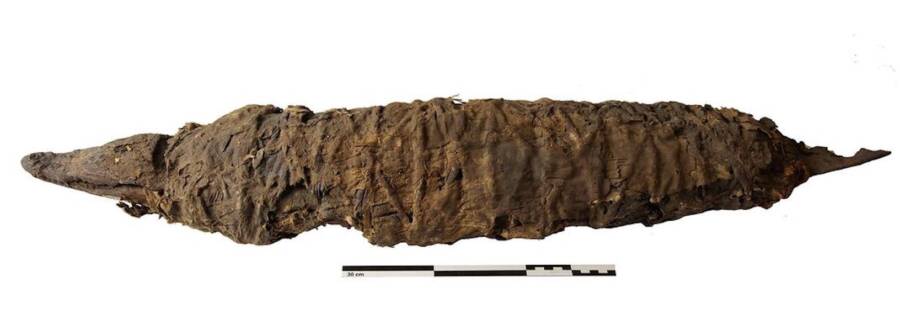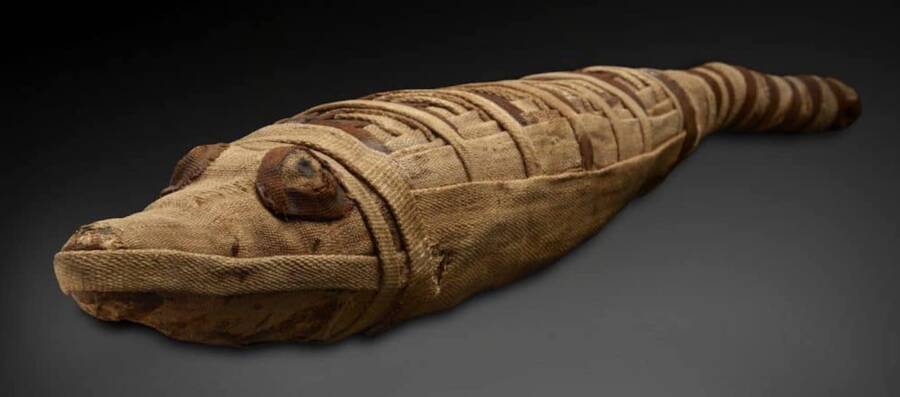A new study found that one crocodile's mummification began "very rapidly after the death," which was caused by blunt force trauma to its head.

Porcier et al.A new study has found that this 2,000-year-old crocodile mummy was embalmed right after its death.
So revered were certain animals in ancient Egyptian culture that these creatures were routinely mummified as sacrifices to the gods. And according to a new study, Egyptian hunters specifically killed them just to sacrifice them — even if they were dangerous beasts like crocodiles.
According to Smithsonian, researchers have found the first concrete evidence of hunting as a method through which Egyptians may have procured animal carcasses for mummification.
The study, published in the Journal of Archaeological Sciences, examined a 2,000-year-old mummified crocodile that was discovered at Kom Ombo.
To examine the corpse without damaging any bones, soft tissue, and the bandages, the archaeologists used synchrotron scanning — and what they found was unbelievable.
“The most probable cause of death is a serious skull fracture on the top of [the] skull that caused a direct trauma to the brain,” the researchers wrote. “The size of the fracture as well as its direction and shape suggest that it was made by a single blow presumably with a… thick wooden club, aimed at the posterior right side of the crocodile, probably when it was resting on the ground.”
Researchers suggest that the hunter, and probably carcasses-for-mummification supplier, likely sneaked up on the beast and whacked it on the head and then took the body away to be turned into a mummy.
Porcier et al.Detailed scans of the layers inside the crocodile mummy.
Furthermore, the study found that the crocodile’s mummification process started “very rapidly after the death,” additionally suggesting that the animals was hunted specifically to be embalmed. The supplier then masked the dent in the animal’s skull from the injury and treated its corpse with oil and resins. Finally, they wrapped the crocodile in layers of linen.
The quick turnaround time of the crocodile’s mummification right after its death is further evidenced by the fact that the mummy’s stomach still contains the animal’s last snacks — reptile eggs, insects, a rodent, and fish.
To determine this, researchers were able to perform a virtual autopsy on the mummified corpse using advanced imaging technology which provided extremely detailed images of each of the mummy’s layers.
They determined that they were dealing with a male juvenile crocodile — likely about three to four years old at the time of its death — with a body length of 3.5 feet.

John WeinsteinClose-up of a crocodile mummy.
In addition to crocodiles, the ancient Egyptians mummified millions of animals, including horses, birds, cats, dogs, and others. These various animals were associated with different gods and their mummified corpses were used as votives to communicate with the god they represented.
“There are falcon mummies associated with the god Horus, cat mummies for Bastet, dog mummies for Anubis, ibis mummies for Thoth,” Brooklyn Museum Curator Edward Bleiberg explained to the Washington Post.
Crocodiles were especially revered by the Egyptians for their strength and association with the Nile and, by extension, fertility. Thus, these ferocious reptiles were typically associated with Sobek, the Egyptian god of fertility who took the form of a half-man, half-reptile.
Thousands of crocodile mummies, some of which were ornately decorated, were found in a crocodile necropolis in the ancient town of Tebtunis in 1899 and 1900, and there is also evidence of crocodile hatcheries and nurseries — both testaments to the crocodile mummy’s popularity and high demand.
While the new analysis of this crocodile mummy’s origins is certainly significant, the study acknowledged that it was impossible to determine whether this specimen was just an anomaly or whether hunting animals specifically for mummification was a common practice.
Next, see inside King Tut’s tomb. Then, discover the most interesting facts about ancient Egypt.





